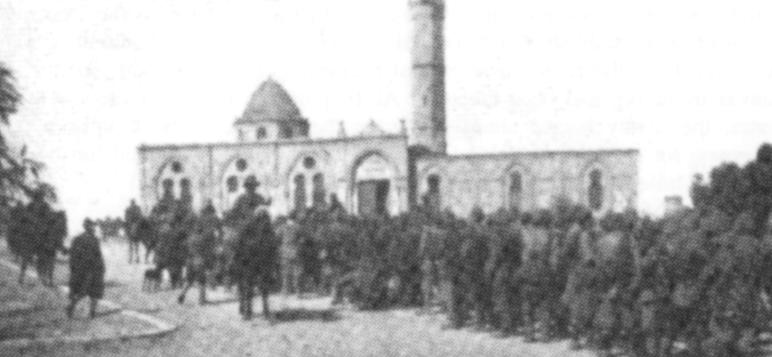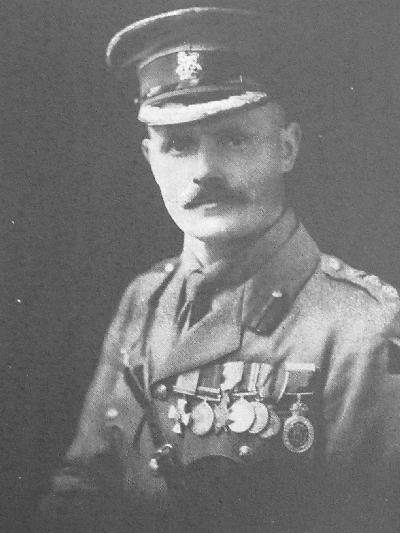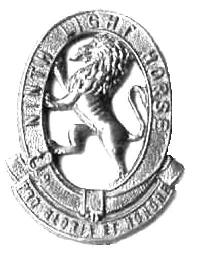Topic: AIF - 3B - 10 LHR
The Battle of Beersheba
Palestine, 31 October 1917
10th LHR, AIF, Unit History Account

[From: Olden, Westralian cavalry in the war, p. 174]
Lieutenant Colonel Arthur Charles Niquet Olden produced the unit history for the 11th LHR in 1921 called the Westralian cavalry in the war: the story of the Tenth Light Horse Regiment, A.I.F., in the Great War, 1914-1918, which included a section specifically related to the battle of Beersheba and is extracted below.
Olden, A.C.N., Westralian cavalry in the war: the story of the Tenth Light Horse Regiment, A.I.F., in the Great War, 1914-1918, (Melbourne 1921), pp. 166 - 172:
CHAPTER XXV.
THE BATTLE OF BEERSHEBA.[166] In setting out this narrative of the doings of the 10th Light Horse Regiment in the Great War, the temptation to offer criticism and personal opinions as to the conception and conduct of operations on the part of the higher formation, has on many occasions, been well nigh irresistible.
These opinions, based for the most part, on individual observation and conjecture only, might well be exposed to the shafts of ridicule from those who were much more highly placed, and consequently in a position of vantage to become au fait with an Army, a Corps, or even a Divisional Scheme.
But it can be no breach of privilege, nevertheless, to record obvious, cold facts, patent to all of average Australian intelligence, which, at the outset of these operations, stood out clear of all other considerations. In the first place, the Army which General Allenby hurled against the Turkish left flank at Beersheba, which swung around and crumpled up the enemy centre at Abu Hareira and Tel es Sheria, which finally smashed Gaza itself to tatters and pushed the Turko-German forces back until the whole of southern Palestine - from Jaffa on the sea to Jerusalem itself - had passed into our keeping, that Army had undergone a vast change since it recoiled, dazed and bewildered, from the Gaza defenders in April.
It was now an Army trained to the minute, efficient, eager, wherein each arm knew its own specific task, and was prepared to tackle that task with confidence. It was an Army whose air service was, at last, more than holding its own. The Commander-in-Chief was a man who was ready to use his cavalry as cavalry, his infantry as infantry, and his artillery as artillery, and who neither over-estimated our own strength, nor under-estimated the tenacity of the enemy.
Secondly, the scheme itself was such a one as appealed to the fighting troops by reason of its boldness and the breadth of vision it displayed.
[167] The Turkish defences had been developed with amazing energy and care until the whole line, from the sea at Gaza to the Judean foothills beyond Beersheba, bristled with a continuous network of trenches and redoubts.
Wherever the enemy expected the blow would fall, it is certain that he did not anticipate that the foothills of Judea could be penetrated by our cavalry in an attempt to crush his left flank. General Allenby however, thought otherwise, and it was with supreme confidence that he sent the whole of his cavalry, commanded by Lieut.-General Chauvel, round by way of these self-same foothills to strike the first blow at the Beersheba flank and rear. How the Desert Mounted Corps, now consisting of three cavalry divisions - the Anzac Mounted Division, the Australian Mounted Division and the Yeomanry Mounted Division carried out its allotted task, has long since passed into history as one of the most striking achievements of the Egyptian Expeditionary Force, so that repetition in a regimental narrative would be superfluous. It is with the part played by the 10th Regiment that we have to do.
On October 28th, 1917, at 4.30 in the afternoon, the 10th Regiment moved out from bivouac at Shellal, joined the remainder of the 3 rd Light Horse Brigade -now under the command of Brigadier-General L.C. Wilson - and marched in column to the Corps rendezvous near Bir-el-Esani. The huge body of horsemen concentrated here during the night and bivouacked until the following evening.
Orders for the battle were not yet to hand, but each unit had formulated a shrewd idea as to how the first blow was to be struck, and on all sides was evidenced the utmost confidence in our success. At ten minutes past five on the following evening (October 29th), the 3rd Brigade moved on in column southeast to Khalasa, a distance of about nine miles. Khalasa was reached at 9.30 p.m., and here the horses were watered from wells which had been previously blown up by the Turks, but were repaired by a party of our Engineers, in conjunction with the Imperial Camel Brigade.
Having watered, the Regiment moved away from the wells and bivouacked for the night at a spot about one and a half miles south. On the following day (October 30th), the orders for battle arrived. The Army was to attack the Beersheba defences on October 31st. Desert Mounted Corps, with the Anzac Mounted Division leading and the Australian Mounted Division in support, would proceed via Asluj along the road running north-easterly to the Wadi Imshash, thence six and a half miles along the Wadi Imshash to cross-roads, and along the road running north-easterly to Iswaiwin. From this point the defences east and northeast of Beersheba, including Tel el Saba, would be attacked and [168] captured. The troops of 20`h Corps, meanwhile, were to attack the enemy works on the Ras Ghannam-Ras Hableim-Hill 1070 line with a view to an advance on Beersheba from the south.
During our halt at Khalasa, several air fights occurred, but on each occasion the enemy machines were shot or driven down in our own territory. Thus the enemy was kept in ignorance of our projected move.
The 10th Regiment rode out from Khalasa at 5 p.m. as advanced guard to the Australian Mounted Division, and followed in the wake of the Anzacs who had already moved ahead.
Asluj was reached at 8 p.m. Here, as at Khalasa, a water supply had been developed by the restoration of partially destroyed wells, on which task the 2nd Light Horse Brigade had been employed for the past few days, protected by covering troops. Only a limited supply however, had been made available, and this was reserved exclusively for draught animals - the riding animals remaining unwatered. A halt was made for about an hour and the march was resumed. The route lay northeast along the bank of the Wadi Sheregi, a troop of "B" Squadron under Lieut. W.C. Palmer guiding the column throughout the night.
Marching continuously, with a ten-minute halt in each hour, the column crossed the Wadi Imshash - a little difficulty being experienced owing to recent rains, which left the Wadi bed heavy and muddy - and at ten minutes past five a.m. (October 31st) our advanced troops were in touch with the Anzac Mounted Division near Point 1504 on the Goz-el-Shegeib. From the high ground the first view was obtained of Beersheba, with its white mosque and buildings standing out against a rugged background of bare, brown, trench-riddled hills.
Advancing to Iswaiwin, the Regiment acting under orders from 3rd Brigade Headquarters, left the road and halted in the broken ground nearby. Here the Australian Mounted Division gradually concentrated and awaited final instructions. Already the Anzac Division was reconnoitring the enemy positions, and the 8th Light Horse Regiment had been detached to fill in a gap between that Division on the right, and 20th Corps on the left, running north-east and southwest from Point 1280 through Point 1180 to Point 1210. Vigorous reconnaissance of the enemy flank disclosed that the Turks were holding Ras Ghannam and Tel el Saba in force, and during the morning orders were received that the main cavalry attack would be delivered against the latter position.[169] Tel-el-Saba is one of those cunningly shaped mounds of great size - known in the Near East as tels - which exist at frequent intervals throughout the country. Their origin is doubtful, opinion being divided as to whether they are natural formations or wholly or partly artificial. Colour is lent to the latter suggestion by reason of the fact that they are of almost uniform shape, and are invariably situated in strategical or tactical positions, which in the days of lighter armaments, must have rendered them of extreme value for defensive purposes.
Even against modern weapons they may by a proper system of entrenchment, be made to offer a serious obstacle, and Tel el Saba had not been neglected in this [170] direction by the Turks. It is situated in the acute angle formed by the junction of the two branches of the Wadi Saba, about three miles east of Beersheba and overlooks open, level ground for a considerable distance. It is almost surrounded by arms of the Wadi, which form a natural moat round its base.
It was well entrenched, and our patrols had reported it held by a considerable force of Turks, with several batteries of artillery in support. Towards midday the Anzac Mounted Division was moving to the attack, whilst our Division was under orders to be prepared to support the Anzacs at a moment's notice.
Meanwhile, the guns of the 20th Corps thundered on our left, and the battle had commenced in earnest. From our positions we could see the burst of heavy shells along the Turkish front, and felt supremely confident that the 60th Division, under Major-General Shea, leading the attack for 20th Corps, would ultimately reach its objective.
The Anzacs were pushing their attack on the right, and at 2 p.m. the 3rd Light Horse Brigade (less the 8th Regiment, employed elsewhere) was ordered into action in support. The 9th and 10th Regiments and the 3rd Machine Gun Squadrons mounted and moved out in that order from the Iswaiwin hills.
The formation adopted was "column of line of troop columns" with double interval and distance. On issuing into the open the whole Brigade came under intense enemy shelling, but the casualties were not heavy, although at this point the 10th Regiment lost a splendid soldier in Captain Rodsted, who was struck from his horse by shrapnel, and succumbed to his wounds a few hours later. Advancing resolutely and without increasing the pace from the walk, the Brigade reached Bir-Salim Abu Irgeig.
From here the 9th Regiment was dispatched to assist in the attack on Tel el Saba on the right of the New Zealand Mounted Rifles, who were driving hard at the Tel with their customary invincible New Zealand dash and courage.
The 9th Regiment rode gallantly across the open ground under heavy shellfire, but before the 9th had dismounted for action, the New Zealanders, by a superb assault, had captured Tel el Saba and its garrison. At 4.30 p.m. the 10t' Regiment was ordered to seize the positions 1020 and 970 - on the west side of the main Hebron road - and cut off any enemy retreat along that road. The Regiment swung out at the trot, under the fire of two batteries of enemy guns, to Point 1020 - half-way between Bir Salim and Tel-el-Saba - and from there galloped across by squadrons in open line of troop columns under salvoes of Turkish shrapnel and high
[171] explosive shells, passed Tel-el-Saba, crossed the Wadi Khalil and the Hebron road, and seized the line 1020-970 at dusk.
Many prisoners were taken, but the guns could not be located in the failing light. Patrols from the 10th Regiment entered Beersheba from the Hebron road, where touch was obtained later with troops of the 1st Light Horse Brigade. From them it was learnt that the final enemy position, which had held out stubbornly to the end, had been captured by the 4th Light Horse Brigade in a brilliant mounted charge with fixed bayonets. This charge has been described by General Allenby as having "decided the day at Beersheba, " and there is no doubt that too much importance cannot be attached to the results achieved by the 4th Brigade on this occasion.
Beersheba, though to a certain extent caught napping, was undoubtedly strong. It contained the only likely water supply for a radius of many miles, which might serve to make it a base for future operations against the Turkish line. Horses and men were already badly in need of water, and for that reason it is more than probable that, could the Turks but have stalled off our attack for another few hours, the whole of the cavalry would have been forced to retire.
The capture of this last position, however, had cleared the way to Beersheba, and the enemy fell back on Sheria, leaving many dead and 2,000 prisoners, 14 guns, and a huge quantity of material, including much rolling stock, in the hands of the Mounted troops.
The troops of the 20th Corps also had succeeded in reaching their first objectives and had taken many prisoners. The 10th Regiment held the 1020-970 positions as an outpost line throughout the night, "C" Squadron, under Major Timperley, meeting with strong opposition from an enemy rear-guard, who advanced and entrenched themselves in front of Hill 1020, but the opening up of machine gun and rifle fire at 9.30 p.m. drove the Turkish rearguard back. The remainder of the night was quiet. At daylight on November Is`, patrols from the Regiment were sent out north and northwest from the outpost line, and returned with more prisoners - stragglers from the Turkish retirement - who confirmed the report that the enemy had fallen back on Tel-el-Sheria. At 5 a.m. two enemy planes flying at low altitude carried out a bombing raid on our portion of the outpost line. Probably the German airmen suspected that we would not possess anti-aircraft guns, and, consequently flew lower than usual. But they were met by a heavy fusillade of rifle and machine gun fire from our troops, and as a result, one machine was shot down and the other driven off.The Regiment remained in its outpost position throughout the day and night, watering the horses at pools in the Wadi Saba near the town. On the following morning (November 2nd) our troops were relieved from the outpost line, and took up a new position one-mile southeast of the town, near the torn-up railway track running in from the south.
[172] For two days this position was occupied, the principal work consisting of development of the Beersheba water supply, to which the Regiment contributed largely in the way of working parties. B2 Echelon of the transport having arrived, advantage was taken of the brief respite by the Regimental shoeing staff in commencing the clipping of horses, many of which were now heavily handicapped by their growing winter coats. Despite the energetic development, the supply of water in the Beersheba area was very heavily taxed. Terrific congestion of animals at the troughs, coupled with the scanty flow of water, was beginning to reduce the watering parades to a farce, and therefore, little or no surprise was occasioned when an order arrived to the effect that the Australian Mounted Division would march back to water at Karm, a distance of about 16 miles. The Anzac and Yeomanry Mounted Divisions were pushing northeasterly and northward from Beersheba, and, for a time, another role was assigned to our own Division.
Further Reading:
10th Australian Light Horse Regiment, AIF
10th Australian Light Horse Regiment, Roll of Honour
The Battle of Beersheba, Palestine, 31 October 1917
Australian and New Zealand Roll of Honour
Battles where Australians fought, 1899-1920
Citation: The Battle of Beersheba, Palestine, 31 October 1917, 10th LHR, AIF, Unit History Account








